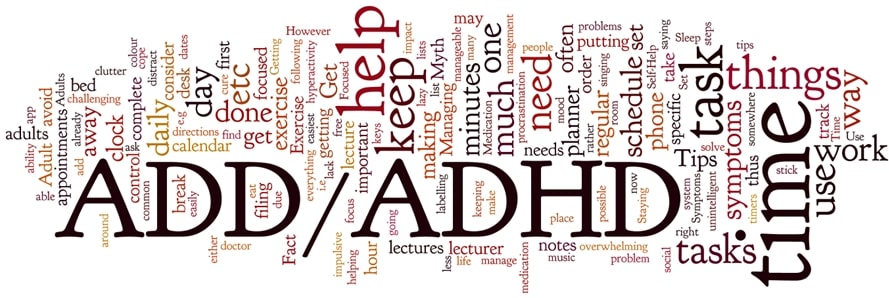Meaning of ADD
Attention deficit disorder (ADD) is a frequent term for a neurological illness characterised by inattention, distractibility, and poor working memory. Adults with ADD symptoms have difficulty focusing on schoolwork, forgetting appointments on a regular basis, losing track of time, and dealing with executive functions. Predominantly Inattentive Attention Deficit Hyperactivity Disorder is a type of attention deficit hyperactivity disorder that patients with these symptoms may have (ADHD). Despite the fact that ADD is no longer a medical diagnosis, it is nevertheless often used to refer to a subset of symptoms that come within the ADHD umbrella.
Meaning of ADHD
The current, official title for the behavioural condition of overactivity and difficulties paying attention is “attention deficit hyperactivity disorder,” abbreviated as “ADHD.” ADHD is one of the most common paediatric neurodevelopmental diseases. It is most diagnosed in the childhood phase of an individual and lasts till adulthood. Children with ADHD may struggle to pay attention, manage impulsive behaviours (doing without considering the consequences), or be extremely active.
Difference Between ADD and ADHD
While discussing and thinking about adhd vs add you might have come to a point that ADD is defined as a milder version of ADHD, or something similar.
However, none of the kinds of ADHD symptoms are inherently more or less severe than the others.
Even within the same family, the intensity of ADHD symptoms might vary greatly. For example, you and a sibling could both have combined ADHD, but one of you may have weaker symptoms.
Even “milder” inattention symptoms can have a significant impact. These symptoms may not have any discernible impact on your behaviour or behaviour at school or at work. However, you may still have trouble concentrating, staying organised, or finishing activities accurately and on time.
If these symptoms are left misdiagnosed and untreated, they may persist into adulthood, posing further obstacles in your life. Getting the right diagnosis and therapy for your symptoms can go a long way toward helping you manage your symptoms effectively.
Diagnosis of ADHD
The core symptoms of inattention, hyperactivity, and impulsivity aren’t enough to diagnose ADHD. Children must not only have 6 or more symptoms for at least 6 months (5 or more for adults), but they must also display symptoms in at least two separate places, such as school, home, job, with friends, or during other activities, before the age of 12.
A mental health practitioner generally will rule out other mental health problems before diagnosing ADHD, including anxiety or mood disorders, substance abuse, abnormalities of the personality and dissociative disorder.
Types of ADHD
Based on the key symptoms involved, experts have recognised three forms of ADHD:
1. Inattentive type
When someone experienced consistent symptoms of inattention and distractibility but little indicators of hyperactivity or impulsivity, a medical or mental health professional might have diagnosed ADD. They’d most likely diagnose ADHD now if the symptoms were primarily inattentive.
Symptoms:
- Easy to be distracted
- Forgetting things in routine life
- Difficulty paying attention to details or listening to what others are saying
- Having trouble focusing on chores or activities
- Difficulty following directions and completing work in a timely manner
- A proclivity to lose attention or become easily distracted
- Having trouble keeping organised or managing your time
- A proclivity to avoid or postpone things that demand sustained mental effort, such as schoolwork or work assignments
- A proclivity for misplacing essential items for regular tasks and activities
2. Hyperactivity & Impulsivity
Hyperactivity and impulsivity are hallmarks of this kind of ADHD, also known as hyperactive-impulsive disorder.
Symptoms:
- Excessive chatting difficulty waiting patiently or taking turns difficulty sitting quietly, remaining motionless, or staying in one spot
- Fidgeting, squirming, or tapping hands and feet frequently fidgeting, squirming, or tapping hands and feet at school, work, or other settings
- Feelings of restlessness that manifest themselves as a desire to run or climb in unsuitable settings
- Playing quietly or engaging in soothing hobbies is difficult for you
- Interrupting others, intruding on conversations and activities, or using others’ belongings without permission is a habit of finishing others’ sentences
- Giving an answer before someone finishes asking a question is a habit of interrupting others.
3. Mix of Inattentiveness & Hyperactivity
Inattentive and hyperactive-impulsive symptoms are seen in people with the mixed type of ADHD.
At least six symptoms from each category must be present in children under the age of seventeen. Adults aged 17 and up must have at least five symptoms.
According to some specialists, the mixed form of ADHD is more common than the other two forms, particularly among adults.
It’s likely that indicators of combined ADHD are easier to spot for parents and instructors. As a result, those with the mixed type may have a better chance of receiving the correct diagnosis because their symptoms are similar to those associated with ADHD. This may create the impression that combined ADHD is more prevalent than other forms of ADHD.





